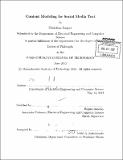| dc.contributor.advisor | Regina Barzilay. | en_US |
| dc.contributor.author | Sauper, Christina (Christina Joan) | en_US |
| dc.contributor.other | Massachusetts Institute of Technology. Dept. of Electrical Engineering and Computer Science. | en_US |
| dc.date.accessioned | 2012-12-13T18:49:04Z | |
| dc.date.available | 2012-12-13T18:49:04Z | |
| dc.date.copyright | 2012 | en_US |
| dc.date.issued | 2012 | en_US |
| dc.identifier.uri | http://hdl.handle.net/1721.1/75648 | |
| dc.description | Thesis (Ph. D.)--Massachusetts Institute of Technology, Dept. of Electrical Engineering and Computer Science, 2012. | en_US |
| dc.description | Cataloged from PDF version of thesis. | en_US |
| dc.description | Includes bibliographical references (p. 129-136). | en_US |
| dc.description.abstract | This thesis focuses on machine learning methods for extracting information from user-generated content. Instances of this data such as product and restaurant reviews have become increasingly valuable and influential in daily decision making. In this work, I consider a range of extraction tasks such as sentiment analysis and aspect-based review aggregation. These tasks have been well studied in the context of newswire documents, but the informal and colloquial nature of social media poses significant new challenges. The key idea behind our approach is to automatically induce the content structure of individual documents given a large, noisy collection of user-generated content. This structure enables us to model the connection between individual documents and effectively aggregate their content. The models I propose demonstrate that content structure can be utilized at both document and phrase level to aid in standard text analysis tasks. At the document level, I capture this idea by joining the original task features with global contextual information. The coupling of the content model and the task-specific model allows the two components to mutually influence each other during learning. At the phrase level, I utilize a generative Bayesian topic model where a set of properties and corresponding attribute tendencies are represented as hidden variables. The model explains how the observed text arises from the latent variables, thereby connecting text fragments with corresponding properties and attributes. | en_US |
| dc.description.statementofresponsibility | by Christina Sauper. | en_US |
| dc.format.extent | 136 p. | en_US |
| dc.language.iso | eng | en_US |
| dc.publisher | Massachusetts Institute of Technology | en_US |
| dc.rights | M.I.T. theses are protected by
copyright. They may be viewed from this source for any purpose, but
reproduction or distribution in any format is prohibited without written
permission. See provided URL for inquiries about permission. | en_US |
| dc.rights.uri | http://dspace.mit.edu/handle/1721.1/7582 | en_US |
| dc.subject | Electrical Engineering and Computer Science. | en_US |
| dc.title | Content modeling for social media text | en_US |
| dc.type | Thesis | en_US |
| dc.description.degree | Ph.D. | en_US |
| dc.contributor.department | Massachusetts Institute of Technology. Department of Electrical Engineering and Computer Science | |
| dc.identifier.oclc | 818328678 | en_US |
